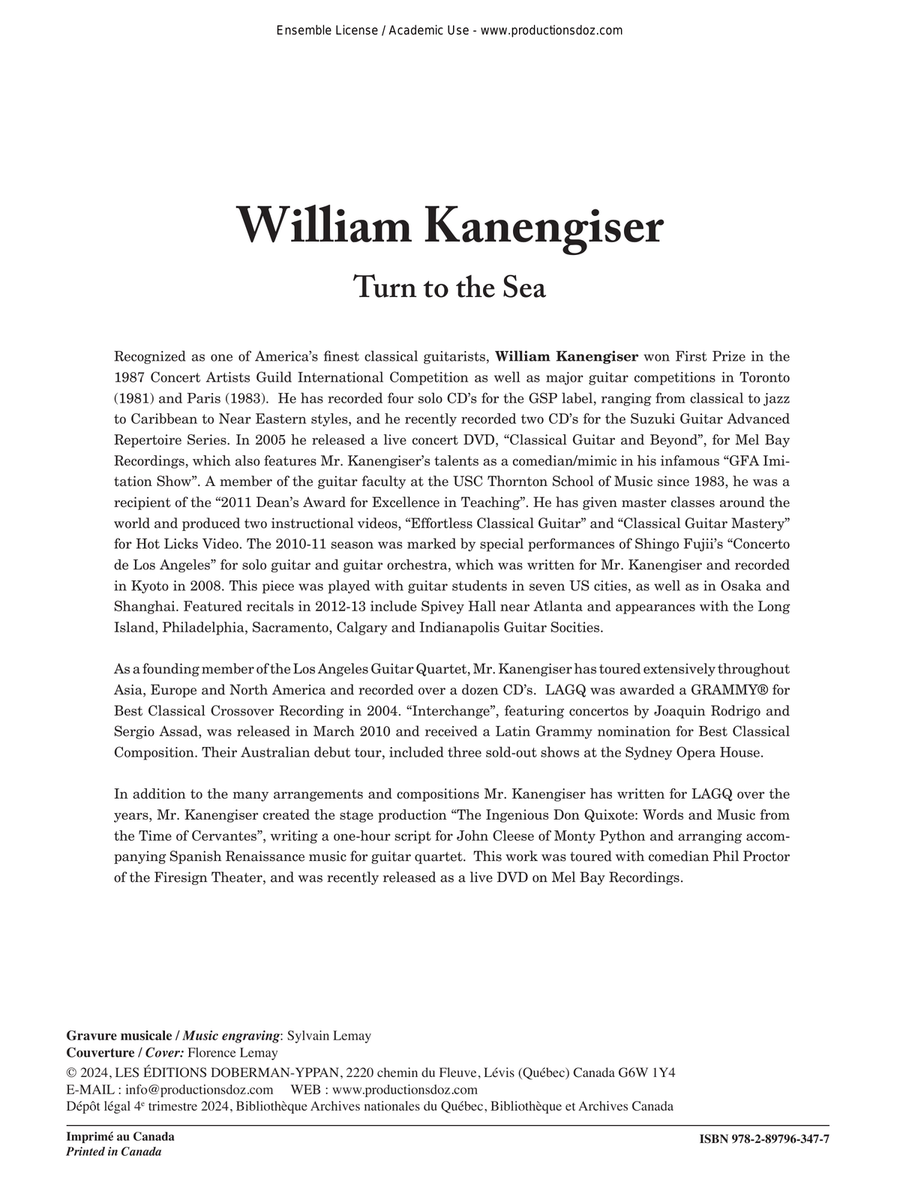Guitar ensemble - Advanced - Digital Download
SKU: ZY.DO-1567-EX
Composed by William Kanengiser.
Ensemble License / Academic Use Score and parts. Les Editions Doberman-Yppan (digital) #DO-1567-EX. Published by Les Editions Doberman-Yppan (digital) (ZY.DO-1567-EX).
Turn to the Sea was written for LAGQ back in 2005, and was the opening track of our "Spin" recording on Telarc. I wrote the piece with a somewhat experimental idea as a starting point: what if it began with each guitarist turning the tuning pegs of one of their strings, and then exploring the possibilities the new tunings created? So, the piece starts one player tuning the 2nd string up to C, another the 1st up to F, then a 5th string down to G, and finally a 4th string down to C, each doing a brief cadenza to test out their new scordatura. A Celtic-inspired melody then enters, accompanied by some richly-voiced chords afforded by the unusual tunings. As the piece progresses, a passacaglia-like ostinato serves as the underpinning of an extended "bass" solo, punctuated by percussive tapping traded back and forth by two players. These tapping effects were also a bit of an experiment; by damping the strings over the fretboard, the tapping produces pitches on the "wrong side" of the string. That is, they sound the note between the fret and the nut, rather than between the fret and the bridge. As the intensity grows and the mood darkens, all four guitars utilize pull-offs onto open strings, reinforcing the B-C and E-F clusters. The opening melody returns in a more celebratory manner, and the piece concludes with all four guitarists re-tuning open strings to finish on an unexpected A major chord.
The piece is also a bit of a meditation on the time signature of 5/4, which then is broken up into various divisions (5/8-5/8, 3/4-3/4-2/4-2/4, etc.) The main melody has a character somewhat reminiscent of a "sea shanty", and the piece as a whole, with its stormy middle section, might be seen as a mini-portrait of an ocean voyage. Despite the overtly maritime association of the title, it also has a double meaning: the piece begins, after all, with a guitarist "turning to the C."
Turn to the Sea a été écrit pour LAGQ en 2005 et était le morceau d’ouverture de notre enregistrement « Spin » sur Telarc. J’ai écrit le morceau avec une idée quelque peu expérimentale comme point de départ : et si cela commençait avec chaque guitariste tournant les chevilles d’une de ses cordes, puis explorant les possibilités créées par les nouveaux accords ? Ainsi, le morceau commence par un joueur accordant la 2e corde jusqu’à C, un autre la 1ère jusqu’à F, puis une 5e corde jusqu’à G, et enfin une 4e corde jusqu’à C, chacun exécutant une brève cadence pour tester sa nouvelle scordatura. Une mélodie d’inspiration celtique entre alors en scène, accompagnée de quelques accords richement exprimés offerts par les accords inhabituels. Au fur et à mesure que le morceau progresse, un ostinato de type passacaille sert de support à un solo de « basse » prolongé, ponctué de tapotements percussifs échangés d’avant en arrière par deux joueurs. Ces effets de tapotements étaient également un peu une expérience ; En amortissant les cordes sur le manche, le tapotement produit des notes du « mauvais côté » de la corde. C’est-à-dire qu’elles font résonner la note entre la frette et le sillet, plutôt qu’entre la frette et le chevalet. Au fur et à mesure que l’intensité augmente et que l’ambiance s’assombrit, les quatre guitares utilisent des pull-offs sur les cordes à vide, renforçant les clusters B-C et E-F. La mélodie d’ouverture revient de manière plus festive, et le morceau se termine avec les quatre guitaristes réaccordant les cordes à vide pour finir sur un accord majeur inattendu en la.
Le morceau est aussi une sorte de méditation sur la signature temporelle de 5/4, qui est ensuite divisée en plusieurs divisions (5/8-5/8, 3/4-3/4-2/4-2/4, etc.) La mélodie principale a un caractère qui rappelle un peu un « chant de marin », et le morceau dans son ensemble, avec sa section médiane orageuse, pourrait être vu comme un mini-portrait d’un voyage en mer. Malgré l’association ouvertement maritime du titre, celui-ci a également une double signification : la pièce commence, après tout, avec un guitariste « se tournant vers le C ».
Digital Downloads are downloadable sheet music files that can be viewed directly on your computer, tablet or mobile device. Once you download your digital sheet music, you can view and print it at home, school, or anywhere you want to make music, and you don’t have to be connected to the internet. Just purchase, download and play!
PLEASE NOTE: Your Digital Download will have a watermark at the bottom of each page that will include your name, purchase date and number of copies purchased. You are only authorized to print the number of copies that you have purchased. You may not digitally distribute or print more copies than purchased for use (i.e., you may not print or digitally distribute individual copies to friends or students).













